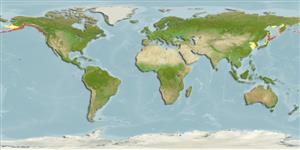Environment: milieu / climate zone / depth range / distribution range
Ecology
Marine; demersal; depth range 0 - 73 m (Ref. 50610). Temperate
Eastern Pacific: Bering Sea coast of Alaska and the Aleutian Islands to Crescent City, northern California, USA. Early records might be misleading since Pholis laeta was once considered identical to Pholis ornatus and was recorded as Pholis ornatus (Ref. 4925).
Size / Weight / Age
Maturity: Lm ? range ? - ? cm
Max length : 25.0 cm TL male/unsexed; (Ref. 2850)
Short description
Identification keys | Morphology | Morphometrics
Facultative air-breathing in the genus (Ref. 126274); Frequently in intertidal areas, in tide pools or under rocks protected by seaweeds (Ref. 2850). May remain out of water under rocks or seaweed (Ref. 31184). Probably feeds on small crustaceans and marine worms (Ref. 28499). Breathes air when out of water (Ref. 31184).
Life cycle and mating behavior
Maturity | Reproduction | Spawning | Eggs | Fecundity | Larvae
Male and female coil around the egg ball (Ref. 58332).
Eschmeyer, W.N., E.S. Herald and H. Hammann, 1983. A field guide to Pacific coast fishes of North America. Boston (MA, USA): Houghton Mifflin Company. xii+336 p. (Ref. 2850)
IUCN Red List Status (Ref. 130435: Version 2024-1)
Threat to humans
Harmless
Human uses
Fisheries: commercial; aquarium: public aquariums
Tools
Special reports
Download XML
Internet sources
Estimates based on models
Preferred temperature (Ref.
123201): 4.1 - 13.5, mean 8.9 °C (based on 232 cells).
Phylogenetic diversity index (Ref.
82804): PD
50 = 0.5005 [Uniqueness, from 0.5 = low to 2.0 = high].
Bayesian length-weight: a=0.00162 (0.00069 - 0.00382), b=3.19 (2.99 - 3.39), in cm total length, based on LWR estimates for this (Sub)family-body shape (Ref.
93245).
Trophic level (Ref.
69278): 3.3 ±0.39 se; based on food items.
Resilience (Ref.
120179): High, minimum population doubling time less than 15 months (Preliminary K or Fecundity.).
Fishing Vulnerability (Ref.
59153): Low vulnerability (15 of 100).
